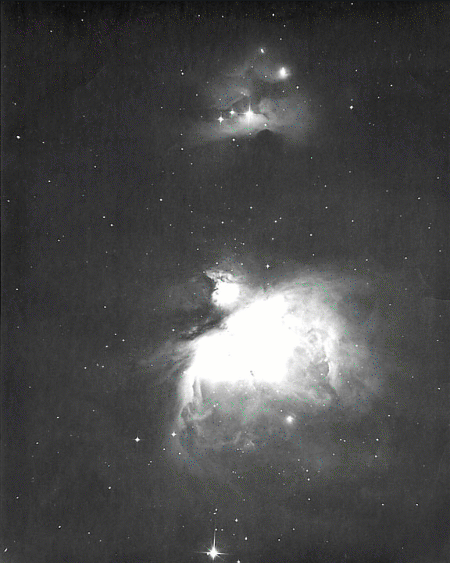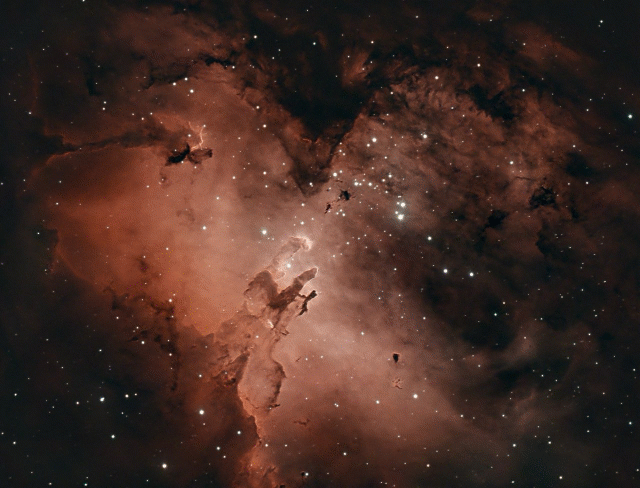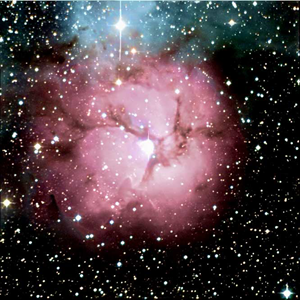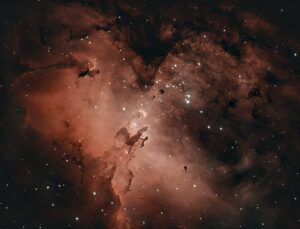Diffuse
Nebulae
A Birthplace for Stars...Amongst Other Things
There is great variety in the gaseous objects known as “nebulae” and they are broadly grouped into four classes. One of these, the so-called “planetaries,” have fairly well defined boundaries, and this website has a page dedicated to their imagery from SRO. On the other hand, a “diffuse” nebula lacks such structure and objects of this type are far more numerous.
Diffuse nebulae fall into three categories based on their means of visibility.
- Emission clouds absorb and re-radiate energy which causes them to glow.
- Reflection nebulas shine by redirecting incident light.
- “Dark clouds absorb and re-radiate energy which causes them to glow.
From birth to death, the fingerprints of stellar evolution can be seen within these various types. Star-forming regions are created when pockets of molecular and partially ionized (HII – “h-two”) hydrogen are dense enough to gravitationally collapse, triggering nuclear fusion. Such radiation will illuminate reflection nebulas or, in the case of massive, UV-rich producers, give rise to emission nebulas. The latter can increase the production of HII within the cloud, evidence that star formation has occurred. Messier 42, the “Great Orion Nebula” is a nearby stellar nursery where such processes are taking place, a handy laboratory for such studies.

M42 - The Great Orion Nebula (NGC 1976)
Roy Ensign
This image has singular importance, for it is the oldest extant recording through the 30-inch telescope at Stony Ridge. It was taken at 4:50AM PDT on 22 September, 1963 almost three weeks after the "First Light" image of 2 September as noted in the Observatory's log book.
SRO optician Roy Ensign must have been delighted by the results of his 10 minute exposure - pinpoint stars among diaphanous tufts of glowing gas as rendered on Kodak's 103aO spectral sensitive emulsion. Large and bright, M42 is a showpiece target, a favored object of both amateur and professional astronomers for generations. Without hyperbole, it is by acclamation the "best in class" diffuse nebula for observers in the northern hemisphere.
However, it is has been a surprising difficult subject for film-based astrophotography because of the wide dynamic range it exhibits. In practice, and as evidenced in this photo, the core of the object completely overwhelms the fainter, outlying parts of the cloud. Multiple exposures and some clever darkroom techniques could have some success in allowing the brighter and darker areas to co-exist, but the process was cumbersome. Modern CCD or CMOS cameras and image processing software make this much, much easier.
The complex around M42 consists of numerous objects as shown. The designation S279 denotes an entry in the *Sharpless catalog and incorporates the objects within the dashed circle, including NGC 1981, a sparse open cluster just outside the field of view.
*The Sharpless catalog is a comprehensive collection of HII regions north of -27 degrees declination. It was compiled in two editions by Stewart L. Sharpless, an American astronomer who made his entries from data found in a subset of the the Palomar Sky Survey. (Additional information may be found here:
https://en.wikipedia.org/wiki/Stewart_Sharpless)

M42 - The Great Orion Nebula (NGC 1976)
Roy Ensign
This image has singular importance, for it is the oldest extant recording through the 30-inch telescope at Stony Ridge. It was taken at 4:50AM PDT on 22 September, 1963 almost three weeks after the "First Light" image of 2 September as noted in the Observatory's log book.
SRO optician Roy Ensign must have been delighted by the results of his 10 minute exposure - pinpoint stars among diaphanous tufts of glowing gas as rendered on Kodak's 103aO spectral sensitive emulsion. Large and bright, M42 is a showpiece target, a favored object of both amateur and professional astronomers for generations. Without hyperbole, it is by acclamation the "best in class" diffuse nebula for observers in the northern hemisphere.
However, it is has been a surprising difficult subject for film-based astrophotography because of the wide dynamic range it exhibits. In practice, and as evidenced in this photo, the core of the object completely overwhelms the fainter, outlying parts of the cloud. Multiple exposures and some clever darkroom techniques could have some success in allowing the brighter and darker areas to co-exist, but the process was cumbersome. Modern CCD or CMOS cameras and image processing software make this much, much easier.
The complex around M42 consists of numerous objects as shown. The designation S279 denotes an entry in the *Sharpless catalog and incorporates the objects within the dashed circle, including NGC 1981, a sparse open cluster just outside the field of view.
*The Sharpless catalog is a comprehensive collection of HII regions north of -27 degrees declination. It was compiled in two editions by Stewart L. Sharpless, an American astronomer who made his entries from data found in a subset of the the Palomar Sky Survey. (Additional information may be found here:
https://en.wikipedia.org/wiki/Stewart_Sharpless)

IC 4703 The "Eagle" / "Star Queen" Nebula
Ryan Kinnett and Jan Ludwinski
This cloud of gas and dust is part of a rich collection of objects within the field of view which includes the star cluster familiarly known as M16, prominent just above center and offset slightly right. The nebula is commonly associated with that Messier number, but its official designation is found within the Index Catalog (IC) companion to the New General Catalog (NGC). On a sky chart, this region lies within Serpens, the "snake," the only one of the eighty-eight "modern" constellations to be broken into two parts: Caput (the serpent's head) and Cauda (its tail), where the nebula resides.
With data obtained through the 30-inch Carroll telescope, the shot might well prove to be historic, ushering SRO into an era of prescribed imaging that aggressively combats light pollution. An Optolong L-Ultimate filter, passing wavelengths primarilly at
two key "gates," one near 500nm (Hydrogen "Alpha") and another close to 656nm (Tripley ionized Oxygen) was attached to the observatory's 2400MC-Pro camera. Thirty, two-minute exposures were made, then processed and combined for the final rendering.
The camera used for this "Eagle" has a color-enabled capture feature versus the strictly monochrome sensor responsible for the corresponding image on the Astro-photography page. While monochrome techniques can deliver superior results, a great deal more effort must be invested to realize those benefits. What is shown above represents a very good compromise whose stunning results - the product of a fine telescope, exquisite camera, and expert software manipulation- speak for themselves.
The muted colors of Kinnett and Ludwinski's image helps show what Robert Burnham Jr. imagined when applying his "Star Queen" description: a woman's oval face and piled hair below and left of center, her outstretched arms raised above and projecting backward over her head. (The left arm is the "eagle's" neck and head.) Burnham Jr., the well-known author of a three volume guide to the observable heavens, favored his moniker since an eagle was already assigned to Aquila, a major constellation in close proximity to Serpens.

IC 4703 The "Eagle" / "Star Queen" Nebula
Ryan Kinnett and Jan Ludwinski
This cloud of gas and dust is part of a rich collection of objects within the field of view which includes the star cluster familiarly known as M16, prominent just above center and offset slightly right. The nebula is commonly associated with that Messier number, but its official designation is found within the Index Catalog (IC) companion to the New General Catalog (NGC). On a sky chart, this region lies within Serpens, the "snake," the only one of the eighty-eight "modern" constellations to be broken into two parts: Caput (the serpent's head) and Cauda (its tail), where the nebula resides.
With data obtained through the 30-inch Carroll telescope, the shot might well prove to be historic, ushering SRO into an era of prescribed imaging that aggressively combats light pollution. An Optolong L-Ultimate filter, passing wavelengths primarilly at
two key "gates," one near 500nm (Hydrogen "Alpha") and another close to 656nm (Tripley ionized Oxygen) was attached to the observatory's 2400MC-Pro camera. Thirty, two-minute exposures were made, then processed and combined for the final rendering.
The camera used for this "Eagle" has a color-enabled capture feature versus the strictly monochrome sensor responsible for the corresponding image on the Astro-photography page. While monochrome techniques can deliver superior results, a great deal more effort must be invested to realize those benefits. What is shown above represents a very good compromise whose stunning results - the product of a fine telescope, exquisite camera, and expert software manipulation- speak for themselves.
The muted colors of Kinnett and Ludwinski's image helps show what Robert Burnham Jr. imagined when applying his "Star Queen" description: a woman's oval face and piled hair below and left of center, her outstretched arms raised above and projecting backward over her head. (The left arm is the "eagle's" neck and head.) Burnham Jr., the well-known author of a three volume guide to the observable heavens, favored his moniker since an eagle was already assigned to Aquila, a major constellation in close proximity to Serpens.
“IC 4703”
@ Full Resolution
(Large file with Zooming and Panning enabled,
Please be patient and allow
link to complete)

M20 (NGC 6514), the Trifid Nebula
This nebula is aptly named for two reasons, the first being its general appearance as a circle consisting of three prominent lobes which radiate from the center in spoke-like fashion. Interestingly enough, the three major types of diffuse nebulosity - emission, reflection, and dark - combine to produce such an appearance. M20 is truly a "three-for."
Like many nebulae possessing a significant HII region, the Trifid is a place where stars are being born.

M20 (NGC 6514), the Trifid Nebula
This nebula is aptly named for two reasons, the first being its general appearance as a circle consisting of three prominent lobes which radiate from the center in spoke-like fashion. Interestingly enough, the three major types of diffuse nebulosity - emission, reflection, and dark - combine to produce such an appearance. M20 is truly a "three-for."
Like many nebulae possessing a significant HII region, the Trifid is a place where stars are being born.
The death of a star can also lead to the creation of diffuse nebula. The Crab nebula in Taurus is a representative example, as is the Veil pictured below. The Crab, so named for its appearance through a substantial (36″) reflecting telescope in Ireland, was created by a supernova explosion first witnessed in 1054 AD throughout east Asia, principally by Chinese astronomers. Its wispy tendrils, the remnants of gas expelled by the rapid collapse of the star’s core, are illuminated by a variety of radiation sources, including gamma and x-rays. The nebula’s genesis also produced a rapidly spinning neutron star – a pulsar – which can only form when the progenitor has sufficient mass.

Eastern Veil Nebula (NGC 6995) and Eastern Bat Nebula (IC 1340)
This tightly framed image from a CCD spans 34.5 arcminutes in width and 14.2 in height and targets the southern portion of the Veil Nebula in Cygnus. Also visible in the photo is a small section of IC 1340, familiarly known as the Bat nebula though its representative appearance isn't apparent here.
The Veil nebula is a vast structure and the major component of the so-called "Cygnus Loop," a complex of nebulosity with several NGC features identified. The Loop spans several square degrees and is roughly circular, created by an unrecorded (but probably observed) supernova event several thousand years ago. Among the highly populated Milky Way star fields of The Swan, this nebular structure consists of both light and dark clouds.
The thinly comprised, outward expanding shell is twisted into delicate filaments, the result of shockwaves generated as the propagating waves of released energy and gas ram into material in their path. Once superheated by collision but now cooled, this is the visible portion we see. Astronomers assume that the brighter parts, found at the periphery, are easier to discern because we are looking through a relatively denser collection of gas atoms at the edge. In much the same way, this is why it's easy to detect the circumference of a soap bubble blown from a child's circular wand.

Eastern Veil Nebula (NGC 6995) and Eastern Bat Nebula (IC 1340)
This tightly framed image from a CCD spans 34.5 arcminutes in width and 14.2 in height and targets the southern portion of the Veil Nebula in Cygnus. Also visible in the photo is a small section of IC 1340, familiarly known as the Bat nebula though its representative appearance isn't apparent here.
The Veil nebula is a vast structure and the major component of the so-called "Cygnus Loop," a complex of nebulosity with several NGC features identified. The Loop spans several square degrees and is roughly circular, created by an unrecorded (but probably observed) supernova event several thousand years ago. Among the highly populated Milky Way star fields of The Swan, this nebular structure consists of both light and dark clouds.
The thinly comprised, outward expanding shell is twisted into delicate filaments, the result of shockwaves generated as the propagating waves of released energy and gas ram into material in their path. Once superheated by collision but now cooled, this is the visible portion we see. Astronomers assume that the brighter parts, found at the periphery, are easier to discern because we are looking through a relatively denser collection of gas atoms at the edge. In much the same way, this is why it's easy to detect the circumference of a soap bubble blown from a child's circular wand.








